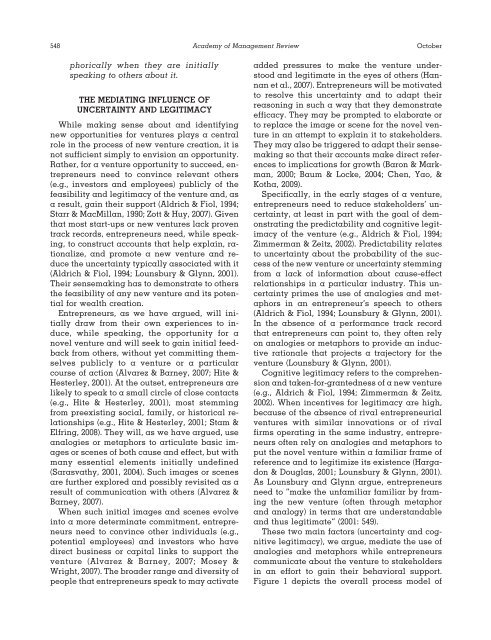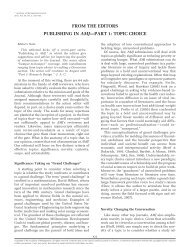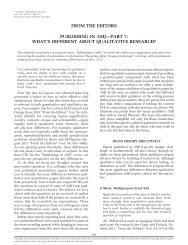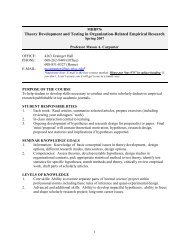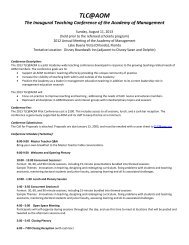inductive reasoning and the creation and justification of new ventures
inductive reasoning and the creation and justification of new ventures
inductive reasoning and the creation and justification of new ventures
Create successful ePaper yourself
Turn your PDF publications into a flip-book with our unique Google optimized e-Paper software.
548 Academy <strong>of</strong> Management Review<br />
October<br />
phorically when <strong>the</strong>y are initially<br />
speaking to o<strong>the</strong>rs about it.<br />
THE MEDIATING INFLUENCE OF<br />
UNCERTAINTY AND LEGITIMACY<br />
While making sense about <strong>and</strong> identifying<br />
<strong>new</strong> opportunities for <strong>ventures</strong> plays a central<br />
role in <strong>the</strong> process <strong>of</strong> <strong>new</strong> venture <strong>creation</strong>, it is<br />
not sufficient simply to envision an opportunity.<br />
Ra<strong>the</strong>r, for a venture opportunity to succeed, entrepreneurs<br />
need to convince relevant o<strong>the</strong>rs<br />
(e.g., investors <strong>and</strong> employees) publicly <strong>of</strong> <strong>the</strong><br />
feasibility <strong>and</strong> legitimacy <strong>of</strong> <strong>the</strong> venture <strong>and</strong>, as<br />
a result, gain <strong>the</strong>ir support (Aldrich & Fiol, 1994;<br />
Starr & MacMillan, 1990; Zott & Huy, 2007). Given<br />
that most start-ups or <strong>new</strong> <strong>ventures</strong> lack proven<br />
track records, entrepreneurs need, while speaking,<br />
to construct accounts that help explain, rationalize,<br />
<strong>and</strong> promote a <strong>new</strong> venture <strong>and</strong> reduce<br />
<strong>the</strong> uncertainty typically associated with it<br />
(Aldrich & Fiol, 1994; Lounsbury & Glynn, 2001).<br />
Their sensemaking has to demonstrate to o<strong>the</strong>rs<br />
<strong>the</strong> feasibility <strong>of</strong> any <strong>new</strong> venture <strong>and</strong> its potential<br />
for wealth <strong>creation</strong>.<br />
Entrepreneurs, as we have argued, will initially<br />
draw from <strong>the</strong>ir own experiences to induce,<br />
while speaking, <strong>the</strong> opportunity for a<br />
novel venture <strong>and</strong> will seek to gain initial feedback<br />
from o<strong>the</strong>rs, without yet committing <strong>the</strong>mselves<br />
publicly to a venture or a particular<br />
course <strong>of</strong> action (Alvarez & Barney, 2007; Hite &<br />
Hesterley, 2001). At <strong>the</strong> outset, entrepreneurs are<br />
likely to speak to a small circle <strong>of</strong> close contacts<br />
(e.g., Hite & Hesterley, 2001), most stemming<br />
from preexisting social, family, or historical relationships<br />
(e.g., Hite & Hesterley, 2001; Stam &<br />
Elfring, 2008). They will, as we have argued, use<br />
analogies or metaphors to articulate basic images<br />
or scenes <strong>of</strong> both cause <strong>and</strong> effect, but with<br />
many essential elements initially undefined<br />
(Sarasvathy, 2001, 2004). Such images or scenes<br />
are fur<strong>the</strong>r explored <strong>and</strong> possibly revisited as a<br />
result <strong>of</strong> communication with o<strong>the</strong>rs (Alvarez &<br />
Barney, 2007).<br />
When such initial images <strong>and</strong> scenes evolve<br />
into a more determinate commitment, entrepreneurs<br />
need to convince o<strong>the</strong>r individuals (e.g.,<br />
potential employees) <strong>and</strong> investors who have<br />
direct business or capital links to support <strong>the</strong><br />
venture (Alvarez & Barney, 2007; Mosey &<br />
Wright, 2007). The broader range <strong>and</strong> diversity <strong>of</strong><br />
people that entrepreneurs speak to may activate<br />
added pressures to make <strong>the</strong> venture understood<br />
<strong>and</strong> legitimate in <strong>the</strong> eyes <strong>of</strong> o<strong>the</strong>rs (Hannan<br />
et al., 2007). Entrepreneurs will be motivated<br />
to resolve this uncertainty <strong>and</strong> to adapt <strong>the</strong>ir<br />
<strong>reasoning</strong> in such a way that <strong>the</strong>y demonstrate<br />
efficacy. They may be prompted to elaborate or<br />
to replace <strong>the</strong> image or scene for <strong>the</strong> novel venture<br />
in an attempt to explain it to stakeholders.<br />
They may also be triggered to adapt <strong>the</strong>ir sensemaking<br />
so that <strong>the</strong>ir accounts make direct references<br />
to implications for growth (Baron & Markman,<br />
2000; Baum & Locke, 2004; Chen, Yao, &<br />
Kotha, 2009).<br />
Specifically, in <strong>the</strong> early stages <strong>of</strong> a venture,<br />
entrepreneurs need to reduce stakeholders’ uncertainty,<br />
at least in part with <strong>the</strong> goal <strong>of</strong> demonstrating<br />
<strong>the</strong> predictability <strong>and</strong> cognitive legitimacy<br />
<strong>of</strong> <strong>the</strong> venture (e.g., Aldrich & Fiol, 1994;<br />
Zimmerman & Zeitz, 2002). Predictability relates<br />
to uncertainty about <strong>the</strong> probability <strong>of</strong> <strong>the</strong> success<br />
<strong>of</strong> <strong>the</strong> <strong>new</strong> venture or uncertainty stemming<br />
from a lack <strong>of</strong> information about cause-effect<br />
relationships in a particular industry. This uncertainty<br />
primes <strong>the</strong> use <strong>of</strong> analogies <strong>and</strong> metaphors<br />
in an entrepreneur’s speech to o<strong>the</strong>rs<br />
(Aldrich & Fiol, 1994; Lounsbury & Glynn, 2001).<br />
In <strong>the</strong> absence <strong>of</strong> a performance track record<br />
that entrepreneurs can point to, <strong>the</strong>y <strong>of</strong>ten rely<br />
on analogies or metaphors to provide an <strong>inductive</strong><br />
rationale that projects a trajectory for <strong>the</strong><br />
venture (Lounsbury & Glynn, 2001).<br />
Cognitive legitimacy refers to <strong>the</strong> comprehension<br />
<strong>and</strong> taken-for-grantedness <strong>of</strong> a <strong>new</strong> venture<br />
(e.g., Aldrich & Fiol, 1994; Zimmerman & Zeitz,<br />
2002). When incentives for legitimacy are high,<br />
because <strong>of</strong> <strong>the</strong> absence <strong>of</strong> rival entrepreneurial<br />
<strong>ventures</strong> with similar innovations or <strong>of</strong> rival<br />
firms operating in <strong>the</strong> same industry, entrepreneurs<br />
<strong>of</strong>ten rely on analogies <strong>and</strong> metaphors to<br />
put <strong>the</strong> novel venture within a familiar frame <strong>of</strong><br />
reference <strong>and</strong> to legitimize its existence (Hargadon<br />
& Douglas, 2001; Lounsbury & Glynn, 2001).<br />
As Lounsbury <strong>and</strong> Glynn argue, entrepreneurs<br />
need to “make <strong>the</strong> unfamiliar familiar by framing<br />
<strong>the</strong> <strong>new</strong> venture (<strong>of</strong>ten through metaphor<br />
<strong>and</strong> analogy) in terms that are underst<strong>and</strong>able<br />
<strong>and</strong> thus legitimate” (2001: 549).<br />
These two main factors (uncertainty <strong>and</strong> cognitive<br />
legitimacy), we argue, mediate <strong>the</strong> use <strong>of</strong><br />
analogies <strong>and</strong> metaphors while entrepreneurs<br />
communicate about <strong>the</strong> venture to stakeholders<br />
in an effort to gain <strong>the</strong>ir behavioral support.<br />
Figure 1 depicts <strong>the</strong> overall process model <strong>of</strong>


